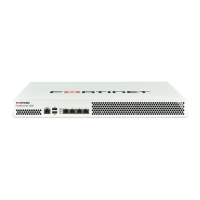System monitoring Page 94 FortiRecorder 2.4.2 Administration Guide
Table 11: Monitor > Video Monitor > Event (viewing the contents of a log file)
Setting name Description
Level Select a severity level to hide log messages that are below this
threshold (see “Log severity levels”).
Subtype Select a subcategory (corresponding to the Subtype column) to hide
log messages whose subtype field does not match.
Go to line Type the index number of the log message (corresponding to the #
column) that you want to jump to in the display.
Search Click to find log messages matching specific criteria (see “Searching
logs”).
Back Click to return to the list of log files stored on FortiRecorder’s hard
drive.
Save View Click to keep your current log view settings for subsequent views and
sessions (see “Displaying & sorting log columns & rows”).
# The index number of the log message within the log file, not the order
of rows in the web UI.
By default, the rows are sorted by timestamp in descending order, the
same as they are within the log file, so the rows are in sequential
order, starting with the most recent log message, number 1, in the top
row. If you change the row sorting criteria (see “Displaying & sorting
log columns & rows”), these index numbers won’t be in the same
order as the rows.
For example, when sorting by the Message column’s contents, the
index numbers of the first 3 rows could be 14, 15, 9.
Note: In the current log file, each log’s index number changes as
new log messages are added, pushing older logs further down the
stack. To find the same log message later, remember its timestamp
and Message, not its #.
Date The date on which the log message was recorded.
When in raw format, this is the log’s date field.
Time The time at which the log message was recorded.
When in raw format, this is the log’s time field.

